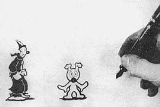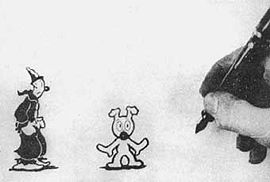
Out of the Inkwell
Encyclopedia

Max Fleischer
Max Fleischer was an American animator. He was a pioneer in the development of the animated cartoon and served as the head of Fleischer Studios...
from 1918 to 1929.
The series was the result of three short experimental films that Max Fleischer independently produced in the period of 1914-1916 to demonstrate his invention, the Rotoscope
Rotoscope
Rotoscoping is an animation technique in which animators trace over live-action film movement, frame by frame, for use in animated films. Originally, recorded live-action film images were projected onto a frosted glass panel and re-drawn by an animator...
, which was a device consisting of a film projector and easel used as an aid for achieving realistic movement for animated cartoons. The Rotoscope would project motion picture film through an opening in the easel, covered by a glass pane serving as a drawing surface. The image on the projected film was traced onto paper, advancing the film one frame at a time as each drawing would be made. Fleischer's younger brother Dave Fleischer
Dave Fleischer
David "Dave" Fleischer was an American animator film director and film producer, best known as a co-owner of Fleischer Studios with his two older brothers Max Fleischer and Lou Fleischer...
was working as a clown at Coney Island, and served as the model for what was to become their first famous character that later evolved as "Koko the Clown
Koko the Clown
Koko the Clown was an animated character created by animation pioneer Max Fleischer. The character originated when Max Fleischer invented the rotoscope, a device that allowed for animation to be more lifelike by tracing motion picture footage of human movement. To test out his new invention...
."
Out of the Inkwell was begun at The Bray Studio
Bray Productions
Bray Productions was the dominant animation studio based in the United States in the years before World War I.- History :The studio was founded in December 1914 by J. R. Bray, perhaps the first studio entirely devoted to animation, and series animation at that...
as a monthly entry in The Bray Pictorgraph Screen Magazine produced for Paramount from 1918 to 1920, and later for Goldwyn in 1921. In that same year, The Fleischer brothers started their own studio, and in 1923, the clown who previously had no name came to be known as KO-KO when animation veteran Dick Huemer
Dick Huemer
Dick Huemer was an animator in the Golden Age of Animation.- Career :...
became the new Director of Animation production. Huemer, who had begun animation with the Mutt and Jeff
Mutt and Jeff
Mutt and Jeff was a long-popular American newspaper comic strip created by cartoonist Bud Fisher in 1907 about "two mismatched tinhorns." It is commonly regarded as the first daily comic strip. The concept of a newspaper strip featuring recurring characters in multiple panels on a six-day-a-week...
cartoons in 1916, brought the influence of that series to "Out of the Inkwell" and created a small canine companion named Fitz. Huemer also redesigned the clown for animation and led the Fleischers away from their dependency on the Rotoscope for animating. He also defined the drawing style with his distinctive inking quality that the series was famous for.
But it was the integration and interaction of the live action sequences starring Max Fleischer as the artist and creator in contest with his pen and ink creations that propelled the series. Typically, the cartoons start out with live action showing the cartoonist (Max) beginning his day. He begins drawing the characters on paper, or he opens the inkwell and they come out and interact with reality.
The "Out of the Inkwell" series ran from 1918 to mid 1927, was renamed "The Inkwell Imps" for Paramount, and continued until 1929. Fleisher continued in the series, serving as actor, producer, writer, and animator for his studio Out of the Inkwell Films, Inc., producing 62 Out of the Inkwell and 56 Inkwell Imps films. While "The Inkwell Imps" series was replaced by the "Talkartoons" in 1929, Koko the Clown returned in 1931 as a supporting character with Bimbo and Betty Boop
Betty Boop
Betty Boop is an animated cartoon character created by Max Fleischer, with help from animators including Grim Natwick. She originally appeared in the Talkartoon and Betty Boop film series, which were produced by Fleischer Studios and released by Paramount Pictures. She has also been featured in...
. Koko's last theatrical appearance was in the "Betty Boop" cartoon, "Ha-Ha-Ha" (1934), which was a remake of the silent "Out of the Inkwell" film, "The Cure" (1924). Koko had a brief cameo in his only color theatrical appearance in the "Screen Song" entry, "Toys will be Toys" (1949).
In 1955, "Out of the Inkwell," along with 2,500 other pre-1950 Paramount shorts and cartoons were sold to television packagers, the majority acquired by U.M.&M. TV Corporation. In 1958, Max Fleischer reactivated his studio in a partnership with Hal Seeger, and in 1960 produced a series of 100 Out Of The Inkwell five minute cartoons. In the new color series, KoKo had a clown girlfriend named KoKette and a villain named Mean Moe. Larry Storch
Larry Storch
Lawrence Samuel "Larry" Storch is an American actor best known for his comic television roles, including voice-over work for top cartoon shows, including Mr...
provided the voice for KoKo and all of the supporting characters.
Filmography
The Bray Studio Years (1918-1920)- Experiment No. 1 (1918)
- Experiment No. 2 (1919)
- Experiment No. 3 (1919)
- The Clown's Pup (1919)
- The Tantalizing Fly (1919)
- Slides (1919)
- The Boxing Kangaroo (1920)
- The Chinaman (1920)
- The Circus (1920)
- The Ouija Board (1920)
- The Clown's Little Brother (1920)
- Poker (1920)
- Perpetual Motion (1920)
- The Restaurant (1920)
- Cartoonland (1921)
- The Automobile Ride (1921)
1921-1926
- Modeling (1921)
- Fishing (1921)
- Invisible Ink (1921)
- The Fish (1922)
- The Dresden Doll (1922)
- The Mosquito (1922)
- Bubbles, Flies (1922)
- Pay Day (1922)
- The Hypnotist (1922)
- The Challenge (1922)
- The Show (1922)
- The Reunion (1922)
- The Birthday (1922)
- Jumping Beans (1923)
- Surprise (1923)
- The Puzzle (1923)
- Trapped (1923)
- The Battle (1923)
- False Alarm (1923)
- Balloons (1923)
- The Fortune Teller (1923)
- Shadows (1923)
- Bed Time (1923)
- The Laundry (1924)
- Masquerade (1924)
- The Cartoon Factory (1924)
- Mother Gooseland (1924)
- A Trip To Mars (1924)
- A Stitch in Time (1924)
- Clay Town (1924)
- The Runaway (1924)
- Vacation (1924)
- Vaudeville (1924)
- League of Nations (1924)
- Sparring Partners (1924)
- The Cure (1924)
- Koko the Hot Shot (1925)
- Koko the Barber (1925)
- Big Chief Koko (1925)
- The Storm (1925)
- Koko Trains 'Em (1925)
- Koko Sees Spooks (1925)
- Koko Celebrates the Fourth (1925)
- Koko Nuts (1925)
- Koko on the Run (1925)
- Koko Packs 'Em (1925)
- Koko Eats (1925)
- Koko's Thanksgiving (1925)
- Koko Steps Out (1925)
- Koko in Toyland (1925)
- My Bonnie September (1925)
- Koko's Paradise (1926)
- Koko Baffles the Bulls (1926)
- It's the Cats (1926)
- Koko at the Circus (1926)
- Toot Toot (1926)
- Koko Hot After It (1926)
- The Fadeaway (1926)
- Koko's Queen (1926)
- Koko Kidnapped (1926)
- Koko the Convict (1926)
- Koko Gets Egg-Cited (1926)
Inkwell Imps (1927-1929)
- Koko Back Tracks (1927)
- Koko Makes 'Em Laugh (1927)
- Koko in 1999 (1927)
- Koko the Kavalier (1927)
- Koko Needles the Boss (1927)
- Ko-Ko Plays Pool (1927)
- Ko-Ko's Kane (1927)
- Ko-Ko the Knight (1927)
- Ko-Ko Hops Off (1927)
- Ko-Ko the Kop (1927)
- Ko-Ko Explores (1927)
- Ko-Ko Chops Suey (1927)
- Ko-Ko's Klock (1927)
- Ko-Ko's Quest (1927)
- Ko-Ko the Kid (1927)
- Ko-Ko's Kink (1928)
- Ko-Ko's Kozy Korner (1928)
- Ko-Ko's Germ Jam (1928)
- Ko-Ko's Bawth (1928)
- Ko-Ko Smokes (1928)
- Ko-Ko's Tattoo (1928)
- Ko-Ko's Earth Control (1928)
- Ko-Ko's Hot Dog (1928)
- Ko-Ko's Haunted House (1928)
- Ko-Ko's Lamp Aladdin (1928)
- Ko-Ko Squeals (1928)
- Ko-Ko's Field Daze (1928)
- Ko-Ko Goes Over (1928)
- Ko-Ko's Catch (1928)
- Ko-Ko's War Dogs (1928)
- Ko-Ko's Chase (1928)
- Ko-Ko Heaves Ho (1928)
- Ko-Ko's Big Pull (1928)
- Ko-Ko Cleans Up (1928)
- Ko-Ko's Parade (1928)
- Ko-Ko's Dog Gone (1928)
- Ko-Ko in the Rough (1928)
- Ko-Ko's Magic (1928)
- Ko-Ko on the Track (1928)
- Ko-Ko's Act (1928)
- Ko-Ko's Courtship (1928)
- No Eyes Today (1929)
- Noise Annoys Ko-Ko (1929)
- Ko-Ko Beats Time (1929)
- Ko-Ko's Reward (1929)
- Ko-Ko's Hot Ink (1929)
- Ko-Ko's Crib (1929)
- Ko-Ko's Saxophonies (1929)
- Ko-Ko's Knock Down (1929)
- Ko-Ko's Signals (1929)
- Ko-Ko's Conquest (1929)
- Ko-Ko's Focus (1929)
- Ko-Ko's Harem Scarum (1929)
- Ko-Ko's Big Sale (1929)
- Ko-Ko's Hypnotism (1929)
- Chemical Ko-Ko (1929)

